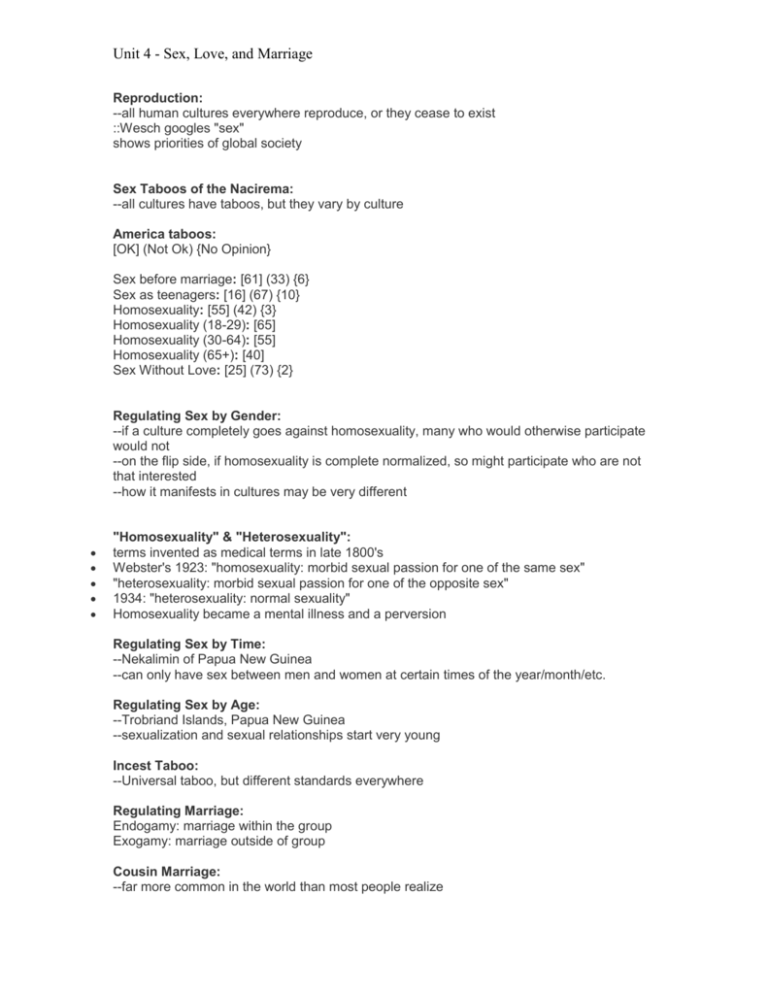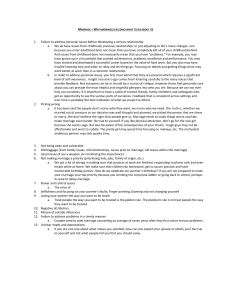
Unit 4 - Sex, Love, and Marriage
Reproduction:
--all human cultures everywhere reproduce, or they cease to exist
::Wesch googles "sex"
shows priorities of global society
Sex Taboos of the Nacirema:
--all cultures have taboos, but they vary by culture
America taboos:
[OK] (Not Ok) {No Opinion}
Sex before marriage: [61] (33) {6}
Sex as teenagers: [16] (67) {10}
Homosexuality: [55] (42) {3}
Homosexuality (18-29): [65]
Homosexuality (30-64): [55]
Homosexuality (65+): [40]
Sex Without Love: [25] (73) {2}
Regulating Sex by Gender:
--if a culture completely goes against homosexuality, many who would otherwise participate
would not
--on the flip side, if homosexuality is complete normalized, so might participate who are not
that interested
--how it manifests in cultures may be very different
"Homosexuality" & "Heterosexuality":
terms invented as medical terms in late 1800's
Webster's 1923: "homosexuality: morbid sexual passion for one of the same sex"
"heterosexuality: morbid sexual passion for one of the opposite sex"
1934: "heterosexuality: normal sexuality"
Homosexuality became a mental illness and a perversion
Regulating Sex by Time:
--Nekalimin of Papua New Guinea
--can only have sex between men and women at certain times of the year/month/etc.
Regulating Sex by Age:
--Trobriand Islands, Papua New Guinea
--sexualization and sexual relationships start very young
Incest Taboo:
--Universal taboo, but different standards everywhere
Regulating Marriage:
Endogamy: marriage within the group
Exogamy: marriage outside of group
Cousin Marriage:
--far more common in the world than most people realize
Unit 4 - Sex, Love, and Marriage
--has to do with family structure
--many times, wealth is passed through patrilineage
--so sometimes a woman is encouraged to marry a male cousin to keep wealth in the family
--many famous people were married to cousins: Einstein, FDR and Eleanor Roosevelt, etc.
--worldwide, 20% of all married couples are cousins
--in the Middle East, it's almost 50%
--in America, it's still taboo out of fear of birth defects in kids
--recent studies show these risks are actually small -- 2-3% more
--age and disease actually increases risks for some issues more than being related
Forms of Marriage:
Monogamy -- one spouse (most common form of marriage)
Polygyny -- more than one wife (preferred form of marriage in about 80% of cultures
worldwide)
Polyandry -- more than one husband
Group Marriage -- mutliple spouses
Polygyny:
--common where women do much of the work
--or where there is a shortage of males
--only the richest where men do most of the work
--often welcomed by women
--Examples: 2wives.com, ChristianPolygamy.com, etc.
Polyandry:
--much more rare than polygyny
--keeps familial land together instead of splitting it between brothers
Same-Sex Marriage:
--still controversial in US, but becoming more accepted
--more common in other parts of the world, especially woman-woman marriages
--sometimes used to pass on wealth in families without male children
--American Anthropological Association eventually made a Statement on Same-Sex
Marriage
--did not support the idea that only heterosexual marriage can provide stable or viable
relationships
Anthropological Definition of Marriage:
"union between two or more people that establishes certain rights and obligations between
the people, between them and their children, and between them and their in-laws."
What about Love?
Bride Price - NOT ABOUT "BUYING AND SELLING" WOMEN
Must be understood in a broader cultural context, which takes into account the differences
between societies structured around gift-giving and those structured around a market
economy.
must ask for parents permission to marry; parents charge a bride price
culture in New Guinea Wesch worked with considers the daughter to be a gift when
approving marriage
the gift of a daughter is extending a relationship across two families (bonding these families
together for life)









